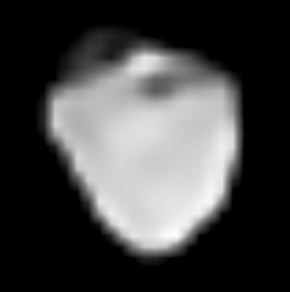Loading AI tools
Large main-belt asteroid From Wikipedia, the free encyclopedia
6 Hebe (/ˈhiːbiː/) is a large main-belt asteroid, containing around 0.5% of the mass of the belt. However, due to its apparently high bulk density (greater than that of the Moon), Hebe does not rank among the top twenty asteroids by volume. This high bulk density suggests an extremely solid body that has not been impacted by collisions, which is not typical of asteroids of its size – they tend to be loosely-bound rubble piles.
 Hebe imaged by the European Southern Observatory's Very Large Telescope | |
| Discovery | |
|---|---|
| Discovered by | Karl Ludwig Hencke |
| Discovery date | 1 July 1847 |
| Designations | |
| (6) Hebe | |
| Pronunciation | /ˈhiːbiː/[1] |
Named after | Hēbē |
| A847 NA; 1847 JB | |
| Main belt | |
| Adjectives | Hebean /hiːˈbiːən/[2] |
| Symbol | |
| Orbital characteristics[3] | |
| Epoch 13 September 2023 (JD 2453300.5) | |
| Aphelion | 2.92 AU (437 million km) |
| Perihelion | 1.93 AU (289 million km) |
| 2.43 AU (364 million km) | |
| Eccentricity | 0.2027 |
| 3.78 yr (1379.85 d) | |
Average orbital speed | 18.93 km/s |
| 144.0° | |
| Inclination | 14.736° |
| 138.63° | |
| 10 March 2022 | |
| 239.59° | |
| Earth MOID | 0.97 AU (145 million km) |
| Proper orbital elements[4] | |
Proper semi-major axis | 2.4252710 AU |
Proper eccentricity | 0.1584864 |
Proper inclination | 14.3511092° |
Proper mean motion | 95.303184 deg / yr |
Proper orbital period | 3.77742 yr (1379.702 d) |
Precession of perihelion | 31.568209 arcsec / yr |
Precession of the ascending node | −41.829042 arcsec / yr |
| Physical characteristics | |
| Dimensions | 205 km × 185 km × 170 km[5][6][7] |
| 195±3 km[8] 186 km[5] | |
| Flattening | 0.25[a] |
| Mass | (1.24±0.24)×1019 kg[8] (1.27±0.13)×1019 kg[b][9] |
Mean density | 3.18±0.64 g/cm3[8] 3.77±0.43 g/cm3[9] |
Equatorial surface gravity | ~0.079–0.099 m/s2 |
Equatorial escape velocity | ~0.127–0.135 km/s (457–486 km/h) |
| 0.3031 d[10] | |
Equatorial rotation velocity | 22.2–24.6 m/s[c] |
| 0.268[8][6] | |
| Temperature | ~170 K max: ~269 K (−4°C) |
| S | |
| 7.5[11] to 11.50 | |
| 5.61[3] | |
| 0.26" to 0.065" | |
In brightness, Hebe is the fifth-brightest object in the asteroid belt after Vesta, Ceres, Iris, and Pallas. It has a mean opposition magnitude of +8.3, about equal to the mean brightness of Saturn's moon Titan,[12] and can reach +7.5 at an opposition near perihelion.
Hebe may be the parent body of the H chondrite meteorites, which account for about 40% of all meteorites striking Earth.
Hebe was discovered on 1 July 1847 by Karl Ludwig Hencke, the sixth asteroid discovered. It was the second and final asteroid discovery by Hencke, after 5 Astraea. The name Hebe, goddess of youth, was proposed by Carl Friedrich Gauss at Hencke's request. Gauss chose a wineglass as its symbol.[13][14] It is in the pipeline for Unicode 17.0 as U+1CEC0 (![]() ).[15][16]
).[15][16]

Hebe was once thought to be the probable parent body of the H chondrite meteorites and the IIE iron meteorites. This would imply that it is the source of about 40% of all meteorites striking Earth. Evidence for this connection includes the following:
However, observations by the VLT in 2017 indicate that the depressions caused by impacts on 6 Hebe are only 20% the volume of the nearby H-chondrite asteroid families, suggesting the Hebe is not the most likely or primary source of H-chondrite meteorites.[17]
This article needs to be updated. (October 2019) |


Lightcurve analysis suggests that Hebe has a rather angular shape, which may be due to several large impact craters.[7] Hebe rotates in a prograde direction, with the north pole pointing towards ecliptic coordinates (β, λ) = (45°, 339°) with a 10° uncertainty.[7] This gives an axial tilt of 42°.
It has a bright surface and, if its identification as the parent body of the H chondrites is correct, a surface composition of silicate chondritic rocks mixed with pieces of iron–nickel. A likely scenario for the formation of the surface metal is as follows:

On 5 March 1977 Hebe occulted Kaffaljidhma (γ Ceti), a moderately bright 3rd-magnitude star. Between 1977 and 2021, 6 Hebe has been observed to occult fourteen stars.
As a result of the aforementioned 1977 occultation, a small moon around Hebe was reported by Paul D. Maley.[20] It was nicknamed "Jebe". This was the first modern-day suggestion that asteroids have satellites. It was 17 years later when the first asteroid moon was formally discovered (Dactyl, the satellite of 243 Ida). The discovery of Hebe's moon was never confirmed.
Seamless Wikipedia browsing. On steroids.
Every time you click a link to Wikipedia, Wiktionary or Wikiquote in your browser's search results, it will show the modern Wikiwand interface.
Wikiwand extension is a five stars, simple, with minimum permission required to keep your browsing private, safe and transparent.